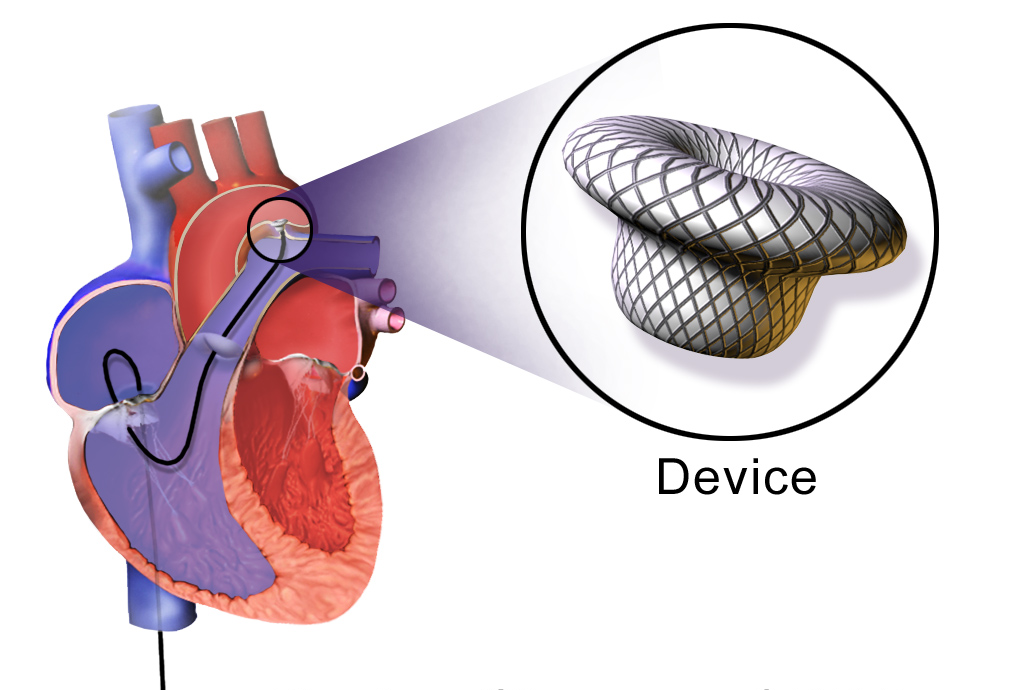Device Closure
Overview
Device closure refers to a minimally invasive procedure used to treat certain structural defects within the body, particularly in the cardiovascular system. This technique involves the insertion of specialized devices or implants through a catheter, typically inserted into a blood vessel, to reach the affected area and close an abnormal opening or defect. This procedure is commonly used to treat conditions such as atrial septal defects (ASDs), patent foramen ovale (PFO), and ventricular septal defects (VSDs).

Why it's done
Device closure is a medical procedure performed to close certain types of structural defects or abnormalities within the body, typically in the heart or other areas. This procedure is commonly used to address specific conditions such as atrial septal defects (ASDs), patent foramen ovale (PFO), and ventricular septal defects (VSDs).
The reasons for performing device closure can vary depending on the condition being treated:
The reasons for performing device closure can vary depending on the condition being treated:
- ASDs (Atrial Septal Defects): These are holes in the wall (septum) between the heart’s upper chambers (atria). Device closure is often recommended to prevent complications such as heart failure, arrhythmias, or stroke by sealing the hole.
- PFO (Patent Foramen Ovale): This is a flap-like opening between the atria that usually closes after birth but remains open in some individuals. Closure might be recommended to prevent the passage of blood clots or bubbles from the right side to the left side of the heart, reducing the risk of stroke or transient ischemic attacks (TIAs).
- VSDs (Ventricular Septal Defects): These are holes in the wall (septum) between the heart’s lower chambers (ventricles). Device closure can be advised to prevent complications such as heart failure, high blood pressure in the lungs, or other related heart problems.
- Minimally invasive: It’s performed using a catheter inserted through a blood vessel, typically in the groin, and guided to the heart, avoiding the need for open-chest surgery.
- Reduced recovery time: Patients usually recover faster compared to open-heart surgery.
- Lower risk of complications: It may carry fewer risks than traditional surgery.
The closure device is a small, specialized implant made of materials that the body can tolerate well. Once positioned in the defect, it remains permanently in place, promoting tissue growth around it to close the hole over time.
Ultimately, device closure is recommended based on the specific characteristics and risks associated with the individual’s condition. The decision to undergo this procedure is typically made after careful evaluation by a cardiologist or a team of medical professionals.
Risk
How do I get ready for Device Closure?
- Consultation and Evaluation: Your healthcare provider, usually a cardiologist or an interventional cardiologist, will evaluate your medical history, perform a physical examination, and might order tests (such as echocardiography, electrocardiogram, or imaging scans) to assess the specific defect and your overall health status.
- Discussion and Informed Consent: You’ll have detailed discussions with your healthcare team about the procedure, including its purpose, potential risks, benefits, alternatives, and what to expect during and after the device closure. It’s crucial to ask any questions you might have and ensure that you understand the procedure fully before giving your informed consent.
- Medications: Your doctor might instruct you to stop or adjust certain medications before the procedure, especially blood thinners or antiplatelet drugs, as they can increase bleeding risk during the intervention.
- Fasting: Typically, you’ll be instructed to avoid eating or drinking anything (including water) for a specific period before the procedure, usually starting midnight on the night before the procedure. However, follow the specific fasting instructions provided by your healthcare team.
- Medical Clearance: If you have other medical conditions or are taking medications for other health issues, your doctor might require medical clearance from other specialists, such as your primary care physician or specialists managing other health conditions.
- Arrange Transportation and Support: Since you might be sedated for the procedure, arrange for someone to drive you home afterward. Additionally, having a family member or friend accompany you to the hospital can provide support and assistance.
- Clothing and Personal Items: Wear comfortable and loose-fitting clothing to the hospital. You might be given a hospital gown to change into before the procedure. Leave valuables and jewelry at home to ensure they’re safe.
- Follow Pre-procedure Instructions: Your healthcare provider will provide specific instructions on pre-procedure preparations, including any skin preparations or special hygiene measures to follow.


